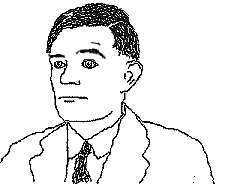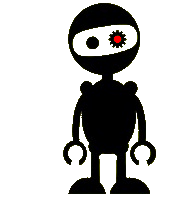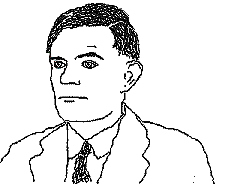 Over the years many variants and improvements to the Turing Test have been proposed, but surely none more unexpected than the one put forward by Andrew Smart in this piece, anticipating his forthcoming book Beyond Zero and One. He proposes that in order to be considered truly conscious, a robot must be able to take an acid trip.
Over the years many variants and improvements to the Turing Test have been proposed, but surely none more unexpected than the one put forward by Andrew Smart in this piece, anticipating his forthcoming book Beyond Zero and One. He proposes that in order to be considered truly conscious, a robot must be able to take an acid trip.
He starts out by noting that computers seem to be increasing in intelligence (whatever that means), and that many people see them attaining human levels of performance by 2100 (actually quite a late date compared to the optimism of recent decades; Turing talked about 2000, after all). Some people, indeed, think we need to be concerned about whether the powerful AIs of the future will like us or behave well towards us. In my view these worries tend to blur together two different things; improving processing speeds and sophistication of programming on the one hand, and transformation from a passive data machine into a spontaneous agent, quite a different matter. Be that as it may, Smart reasonably suggests we could give some thought to whether and how we should make machines conscious.
It seems to me – this may be clearer in the book – that Smart divides things up in a slightly unusual way. I’ve got used to the idea that the big division is between access and phenomenal consciousness, which I take to be the same distinction as the one defined by the terminology of Hard versus Easy Problems. In essence, we have the kind of consciousness that’s relevant to behaviour, and the kind that’s relevant to subjective experience.
Although Smart alludes to the Chalmersian zombies that demonstrate this distinction, I think he puts the line a bit lower; between the kind of AI that no-one really supposes is thinking in a human sense and the kind that has the reflective capacities that make up the Easy Problem. He seems to think that experience just goes with that (which is a perfectly viable point of view). He speaks of consciousness as being essential to creative thought, for example, which to me suggests we’re not talking about pure subjectivity.
Anyway, what about the drugs? Smart sedans to think that requiring robots to be capable of an acid trip is raising the bar, because it is in these psychedelic regions that the highest, most distinctive kind of consciousness is realised. He quotes Hofman as believing that LSD…
…allows us to become aware of the ontologically objective existence of consciousness and ourselves as part of the universe…
I think we need to be wary here of the distinction between becoming aware of the universal ontology and having the deluded feeling of awareness. We should always remember the words of Oliver Wendell Holmes Sr:
…I once inhaled a pretty full dose of ether, with the determination to put on record, at the earliest moment of regaining consciousness, the thought I should find uppermost in my mind. The mighty music of the triumphal march into nothingness reverberated through my brain, and filled me with a sense of infinite possibilities, which made me an archangel for the moment. The veil of eternity was lifted. The one great truth which underlies all human experience, and is the key to all the mysteries that philosophy has sought in vain to solve, flashed upon me in a sudden revelation. Henceforth all was clear: a few words had lifted my intelligence to the level of the knowledge of the cherubim. As my natural condition returned, I remembered my resolution; and, staggering to my desk, I wrote, in ill-shaped, straggling characters, the all-embracing truth still glimmering in my consciousness. The words were these (children may smile; the wise will ponder): “A strong smell of turpentine prevails throughout.”…
A second problem is that Smart believes (with a few caveats) that any digital realisation of consciousness will necessarily have the capacity for the equivalent of acid trips. This seems doubtful. To start with, LSD is clearly a chemical matter and digital simulations of consciousness generally neglect the hugely complex chemistry of the brain in favour of the relatively tractable (but still unmanageably vast) network properties of the connectome. Of course it might be that a successful artificial consciousness would necessarily have to reproduce key aspects of the chemistry and hence necessarily offer scope for trips, but that seems far from certain. Think of headaches; I believe they generally arise from incidental properties of human beings – muscular tension, constriction of the sinuses, that sort of thing – I don’t believe they’re in any way essential to human cognition and I don’t see why a robot would need them. Might not acid trips be the same, a chance by-product of details of the human body that don’t have essential functional relevance?
The worst thing, though, is that Smart seems to have overlooked the main merit of the Turing Test; it’s objective. OK, we may disagree over the quality of some chat-bot’s conversational responses, but whether it fools a majority of people is something testable, at least in principle. How would we know whether a robot was really having an acid trip? Writing a chat-bot to sound as if were tripping seems far easier than the original test; but other than talking to it, how can we know what it’s experiencing? Yes, if we could tell it was having intense trippy experiences, we could conclude it was conscious… but alas, we can’t. That seems a fatal flaw.
Maybe we can ask tripbot whether it smells turpentine.




 In The Most Human Human: A Defence of Humanity in the Age of the Computer, Brian Christian gives an entertaining and generally sensible account of his campaign to win the ‘most human human’ award at the Loebner prize.
In The Most Human Human: A Defence of Humanity in the Age of the Computer, Brian Christian gives an entertaining and generally sensible account of his campaign to win the ‘most human human’ award at the Loebner prize.
 I was interested to see this Wired
I was interested to see this Wired  Ah, the oft-promised passing of the Turing Test. Wake me up when it happens – we’ve been round this course so many times in the past.
Ah, the oft-promised passing of the Turing Test. Wake me up when it happens – we’ve been round this course so many times in the past. The New Scientist, under the title ‘Tests that show machines closing in on human abilities’ has
The New Scientist, under the title ‘Tests that show machines closing in on human abilities’ has 